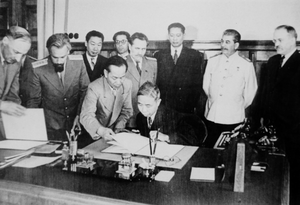Sino-Soviet Treaty of Friendship and Alliance
You can help expand this article with text translated from the corresponding article in Chinese. (February 2022) Click [show] for important translation instructions.
|
You can help expand this article with text translated from the corresponding article in Russian. (February 2022) Click [show] for important translation instructions.
|
 | |
| Signed | 14 August 1945 |
|---|---|
| Expiry | 24 February 1953 |
| Signatories | |

The Treaty of Friendship and Alliance (Traditional Chinese:
Ili National Army, which were rebelling in Xinjiang.[1] Both nations also agreed upon joint control of the Chinese Eastern Railway and to facilitate its eventual return to full Chinese sovereignty.[2]
However, China noticed that the Soviet Union secretly and continuously supported the
UN General Assembly adopted Resolution 505 on 1 February 1952, which confirmed that the Soviet Union had violated the terms of the treaty by assisting the Chinese Communist Party during the Chinese Civil War
.
On 24 February 1953, the
Republic of China
voted to officially terminate its commitments to the Sino-Soviet Treaty of Friendship and Alliance as well and rescinded its recognition of the independence of the Mongolian People's Republic.
See also
- Sino-Soviet Treaty of Friendship, Alliance and Mutual Assistance
- United Nations General Assembly Resolution 505
- Mongolia–Taiwan relations
References
- ^ Atwood, Christopher (2005). "Poems of Fraternity: Literary Responses to the Attempted Reunification of Inner Mongolia and the Mongolian People's Republic". In Kara, György (ed.). The Black Master: Essays on Central Eurasia in Honor of György Kara on His 70th Birthday. Otto Harrassowitz Verlag. p. 2.
- ^ Zhang Shengfa, "Return of the Chinese Changchun Railway to China by the USSR." In Manchurian Railways and the Opening of China, 171-94. 1st ed. Vol. 1. New York, NY: Taylor & Francis Group, 2010. p, 171.
